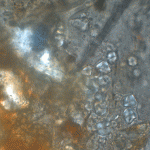
Artist's impression of the laser-based sensor augmenting a Pitot tube. Credit: Sven Wittig
The laser light velocity sensors have been successfully tested in a high-speed wind tunnel.
University of New South Wales (UNSW) engineers have developed a low-cost laser that can accurately and speedily measure the velocity of commercial aircraft. Instead of having physical components located in the airflow, the new laser light system can be located in a temperature-controlled environment inside the plane, which will hopefully reduce the number of plane crashes.
The currently used velocity sensors, known as Pitot tubes, are susceptible to icing over in bad weather and have been suggested as possible failure points for several fatal aircraft accidents. The most notable of these was Air France Flight 447, which crashed into the Atlantic Ocean in 2009; 216 passengers and 12 crew members died.
Investigators suspect that a severe storm caused the forward-facing holes on the Pitot tubes to fill with ice, so the crew couldn’t accurately estimate velocity. “Pitot tubes are simple and reliable instruments, but when they get obstructed, either by ice, dirt build-up, or by birds or insects flying into them, they don’t tell you your correct speed,” says Dr Sean O’Byrne from UNSW Canberra. “Then you need to rely on backup plans, like GPS, which in storm conditions may not do the job.”
O’Byrne and PhD student Sven Wittig developed the lasers in parallel to their work with the SCRAMSPACE project. The system uses the same technology as laser computer mice and measures velocity using the Doppler shift of the light absorbed by the oxygen molecules.
To see if they worked at lower speeds, the researchers needed to generate airspeeds equivalent to that of commercial aircraft. They set up a rig and successfully tested the laser-based sensor in a high-speed wind tunnel that operates up to sonic airspeeds, using facilities provided by the Defence Science and Technology Organisation in Melbourne.
“The technology we have developed measures airspeed like a Pitot tube, but doesn’t have something poking out into the air,” O’Byrne says. “It has a window, which can be built into a recess in the body of the plane, and which can be heated. This also means, in sudden icing situations, it can be kept out of the wind.”
The next step will be to scale down the proof-of-concept laser into an aircraft-ready design and conduct flight tests. Rather than replacing the existing system, the researchers say the lasers could be used to complement the Pitot tubes, which will give flight crews more confidence in the readings. “There’s no need to get rid of them, but there’s certain conditions where they stop working,” O’Byrne explains.







jun admana
August 7, 2012
It is about time. What about fail safe methods of determining the real contents of the fuel tanks? That the landing gears are really down? That cargo bay doors are really shut tight? That the cargo hold is constantly monitored of smoke or fire?
Cheers.
jun a.